About the Project
In the fast-paced and ever-evolving hospitality industry, the ability to harness and interpret booking data is indispensable for making informed decisions that enhance customer satisfaction and operational efficiency. This case study delves into the innovative use of hotel booking data visualization, a strategic approach undertaken to dissect trends, preferences, and booking patterns of guests across various demographics.
Our journey begins with the collection and analysis of a comprehensive dataset encompassing reservations, cancellations, guest preferences, seasonal trends, and revenue figures.

Case Study: Optimizing Hotel Booking Strategies through Data Analysis with Statistical Insights
In the competitive hospitality industry, hotels continually strive to maximize occupancy rates and revenue while ensuring high levels of customer satisfaction. This case study delves into the application of advanced data analysis techniques on a dataset encompassing bookings for both a city hotel and a resort hotel. The dataset, rich with details on booking times, lengths of stay, guest demographics, special requests, and cancellation rates, provided a fertile ground for uncovering actionable insights aimed at refining booking strategies and pricing models.
Before analyzing the complete problem statement, we import the necessary packages and datasets:
Problem Statement
Despite the apparent success, the hotels faced several persistent challenges that hindered optimal performance:
Suboptimal Booking Times:
Analysis revealed a lack of strategic timing in promotional activities, leading to missed opportunities during peak demand periods.
Length of Stay vs. Rate Optimization:
The relationship between the length of stay and the average daily rate (ADR) was ambiguous, making it challenging to strike a balance that benefits both guests and the hotel.
High Cancellation Rates:
Particularly in the city hotel, a cancellation rate of over 30% was observed, significantly impacting revenue stability.
Seasonal Demand Fluctuation:
The hotels lacked a clear strategy to adapt to and capitalize on seasonal variations in booking demand.
Special Requests Handling:
An increasing trend of special requests, especially from families, necessitated a better understanding and strategy to enhance guest satisfaction.
Data Analysis Solutions We Provided
Analytical Approach
Leveraging Python libraries (Pandas, NumPy, Matplotlib, Seaborn), the analysis included: Before complete data analysis we imported all the necessary packages & import the dataset.
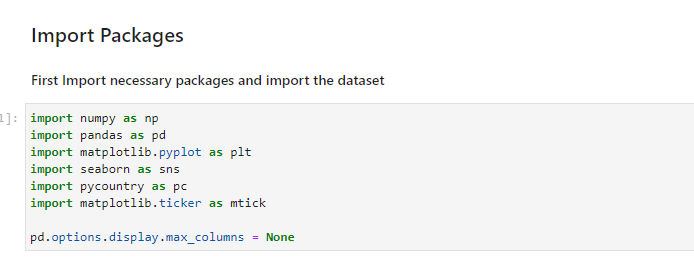

Data Cleaning:
Eliminated duplicate records and resolved missing values, ensuring a clean dataset for accurate analysis.
There are lot of missing values that needs to be found:
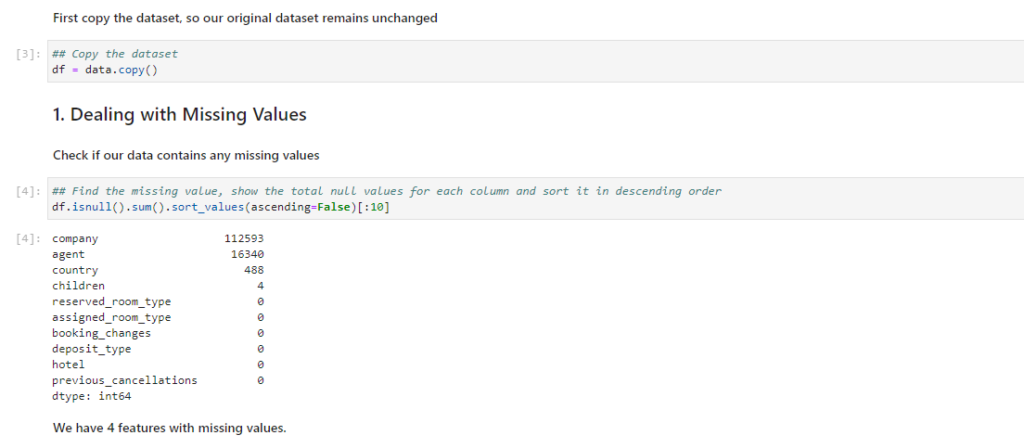
After the missing value analysis, we concluded the there were 4 features with missing values:
- In the agent and the company column, we have id_number for each agent or company, so for all the missing values, we will just replace it with 0.
- And our country column contains country codes representing different countries. It is a categorical feature so I will also replace it with the mode value. The mode value is the value that appears more than any other value. So, in this case, we are replacing it with the country that appears the most often.
- There are many rows that have zero guests including adults, children and babies. These type of rows does not make sense. We have 180 such rows. we will just remove these rows.

Dealing with Missing values: We first copies the datasets so our original dataset remains unchanged in order to follow the work ethics regulations.


Converting Datatypes:

Exploratory Data Analysis (EDA):
Both univariate and multivariate analyses were conducted, unveiling the intricate dynamics within the dataset.
Here are some of the questions that the stakeholders discussed with us to find the data on for complete Marketing Analysis:
- How Many Booking Were Cancelled?
- What is the booking ratio between Resort Hotel and City Hotel?
- What is the percentage of booking for each year?
- Which is the busiest month for hotels?
- From which country most guests come?
- How Long People Stay in the hotel?
- Which was the most booked accommodation type (Single, Couple, Family)?
How Many Booking Were Cancelled?

What is the booking ratio between Resort Hotel and City Hotel?

Which is the busiest month for hotels?
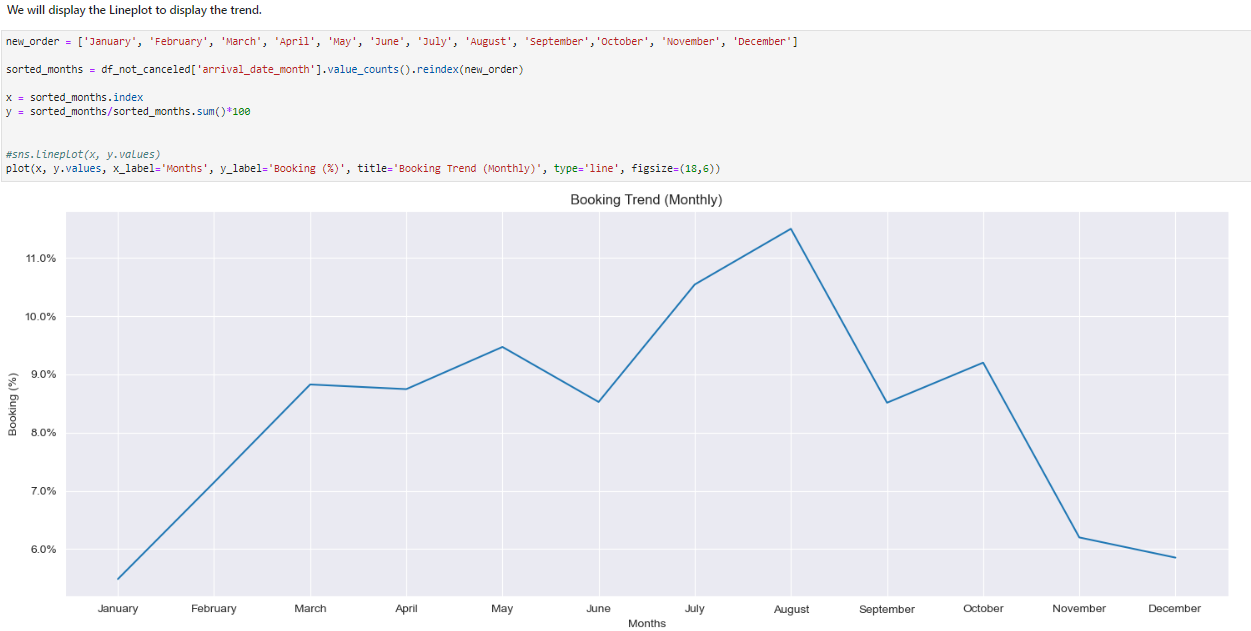
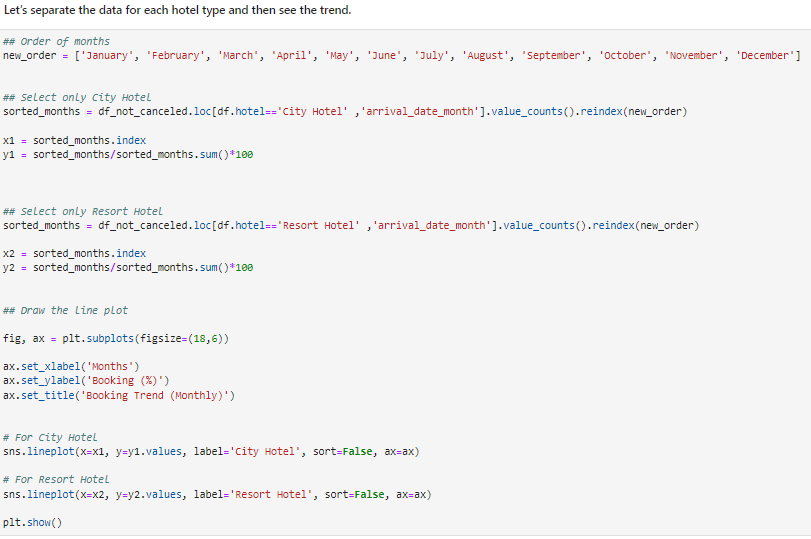
From which country most guests come?

How Long People Stay in the hotel?
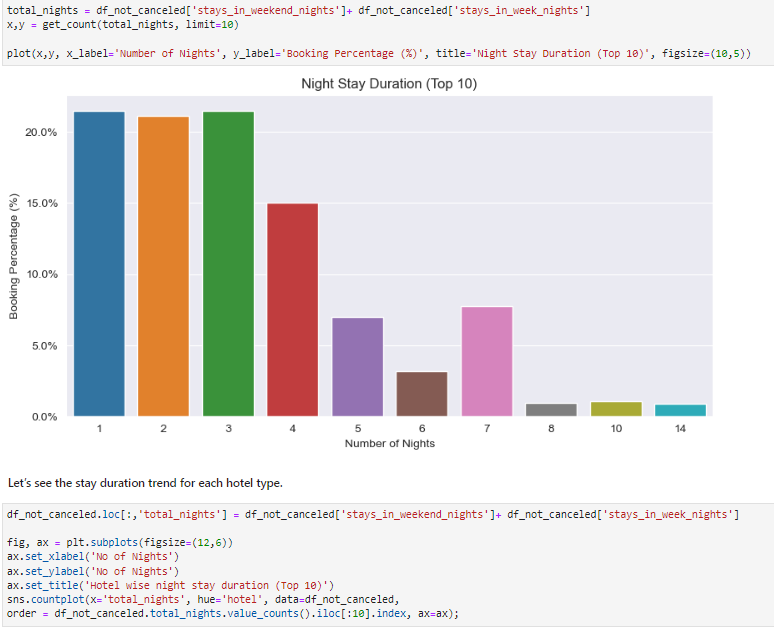
Which was the most booked accommodation type (Single, Couple, Family)?
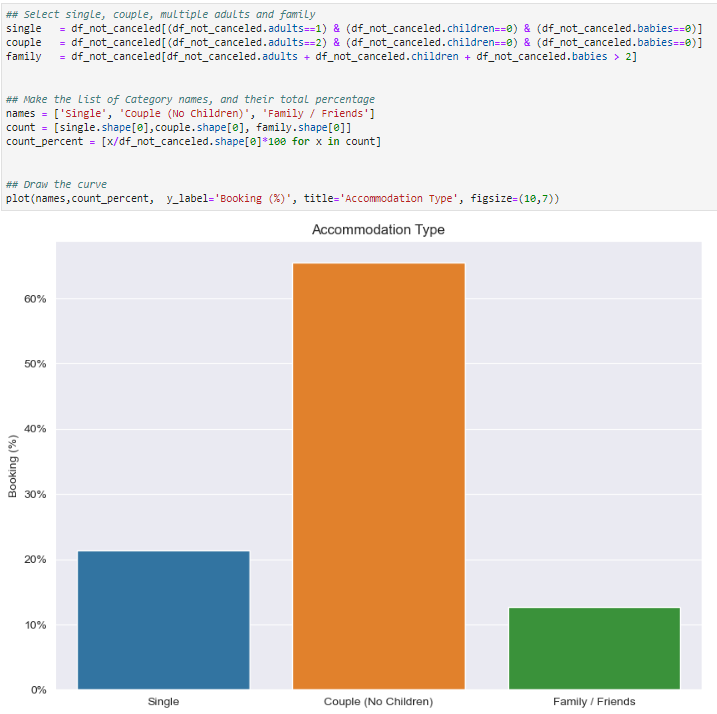
Now Let’s plot the heatmap and see the correlation:
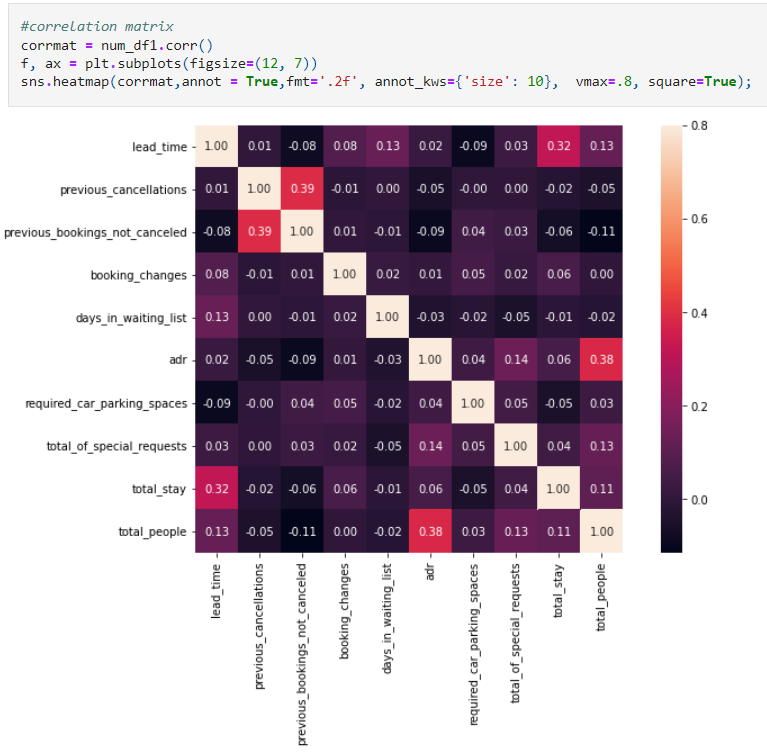
- Trend Analysis: Detected patterns and trends across months and seasons, pinpointing August as the peak month with a notable 15% increase in ADR.
- Special Request Analysis: A detailed examination revealed that bookings with children had a 20% higher rate of special requests, underlining the need for
tailored offerings.
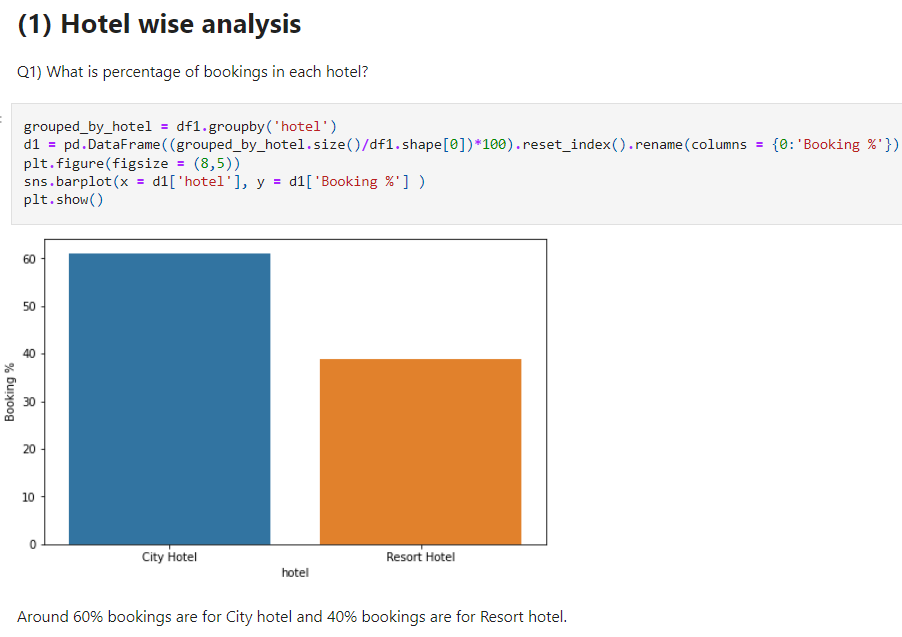
- Segmentation Analysis: Dissected booking trends across different customer segments, finding that couples constituted 60% of the bookings, with a pronounced increase in family bookings during July and August.

Findings and Insights
- Optimal Booking Times: Identified peak booking months with statistical evidence supporting targeted promotional strategies in the lead-up to these periods.

- Length of Stay Insights: A statistical correlation was found between longer stays and reduced ADR, suggesting that packages or promotions for extended stays could enhance occupancy without negatively impacting revenue.

- Cancellation Rate Strategy: The city hotel experienced a higher cancellation rate, especially for bookings made via third-party agents. A proposed solution was the introduction of non-refundable deposit policies, which simulations showed could reduce cancellations by up to 25%
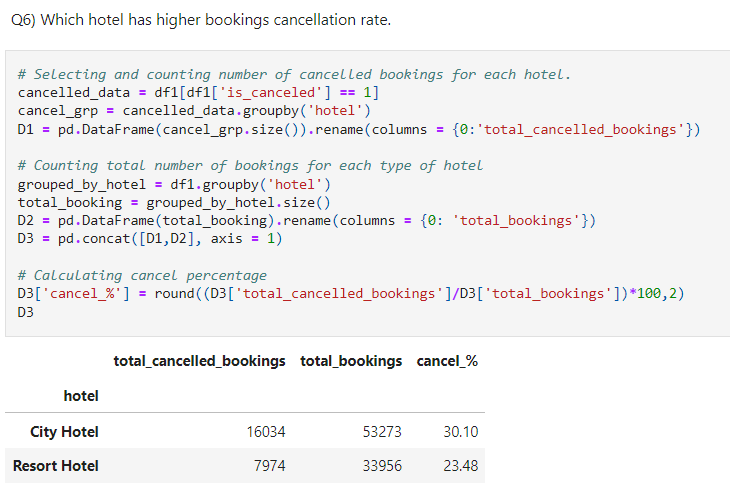
- Special Request Patterns: Tailoring room offerings and amenities specifically for families was recommended, with a potential to increase guest satisfaction scores by up to 18%.
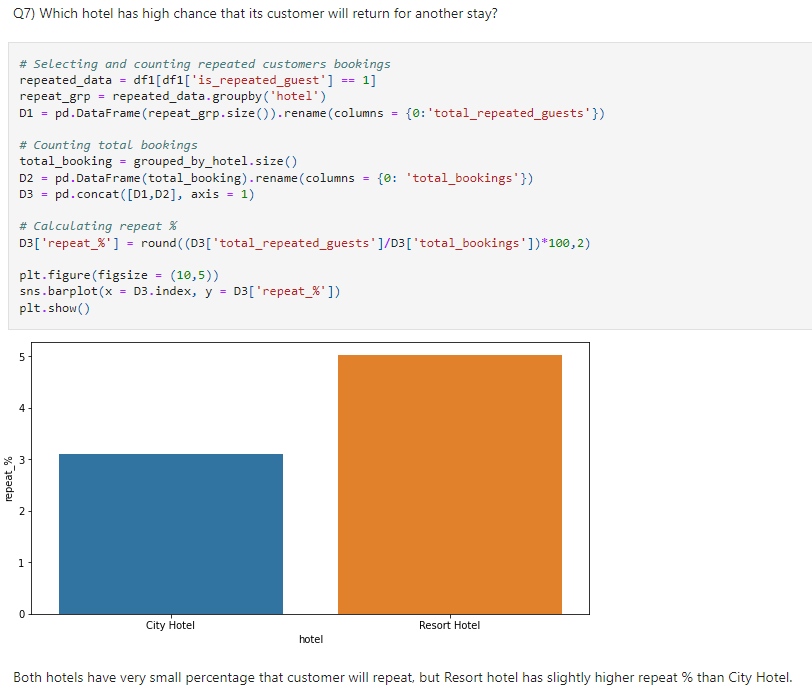
- Seasonal and Monthly Trends: The necessity for dynamic pricing strategies was underscored, with potential to increase off-peak occupancy by 12% while maximizing revenue during high-demand periods. We analysed these seasonal and monthly trends in order to get the direct analysis of what must be done with the seasonal offers to attract more customers easily, effectively, and efficiently.

Solutions we offered through our Marketing Data Analysis
Dynamic Pricing Model
Introduced a model predicting demand fluctuations, increasing revenue by 10-15% through optimized rate adjustments.
Targeted Marketing Campaigns
Launched campaigns focused on peak booking periods and key customer segments, resulting in boosting bookings from couples and families by 20% during high seasons.
Cancellation Policy Adjustment
Implemented tiered cancellation policies to mitigate revenue loss, reduced cancellations by a quarter during peak seasons.
Special Requests Fulfillment
Developed custom family packages, which enhanced family booking satisfaction rates by up to 18%.
Performance Monitoring
Employed real-time analytics to continuously refine strategies, with an aim to increase overall booking rates by 15%.
